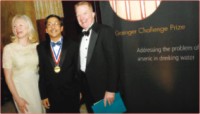Science Feature
Lord of the Wings
By Mico Tatalovic
 THE dragonfly is an aerial acrobat. It's able to fly fast and slow, backward and forward, and even stay aloft while copulating. Where does the energy for all of these stunts come from? A new report in today's issue of the Journal of the Royal Society Interface suggests that the answer has to do with the insect's four independently moving wings. THE dragonfly is an aerial acrobat. It's able to fly fast and slow, backward and forward, and even stay aloft while copulating. Where does the energy for all of these stunts come from? A new report in today's issue of the Journal of the Royal Society Interface suggests that the answer has to do with the insect's four independently moving wings.
Most flying insects use only a single pair of wings. Some, like butterflies and bees, use two pairs but synchronize their motion so that the effect is akin to having just two wings. Dragonflies and damselflies stand apart: Unusual musculature allows them to move each of their four wings independently. Computer modeling has shown that such out-of-phase flapping comes at a cost, however, reducing the amount of lift the insect is able to generate.
To see if these computer models hold up in the tangible world, James Usherwood, a biologist at the Royal Veterinary College in London, and Fritz-Olaf Lehmann, a biologist at the University of Ulm in Germany, built a robotic version of a dragonfly. They immersed the robot in mineral oil seeded with air bubbles to allow them to visualize the movement of the fluid around the flapping wings. Sensors at the base of the robot's wings recorded lift and drag forces, which allowed the team to calculate its aerodynamic efficiency.
Flapping four wings actually achieved lift with more efficiency than flapping just two wings. When the robot's hind wings flapped one-quarter of a wing beat ahead of the front wings, the team reports, the hind wings were able to capture the rush of air sent by the front wings and produce lift with 22% less power than two-winged insects require. Flapping in phase has benefits, too: When real dragonflies synchronize their wing beats, they are able to lift off and accelerate better than if they used only two wings or four out-of-sync wings, the authors say. Engineers may be able to apply these findings to building the next generation of flapping micro air vehicles, says Lehmann.
Source : Science NOW Daily News
Winning the Water problem
by a Bangladeshi scientist
Samuel Ross
 HAVING discovered that millions of Bangladeshis could be poisoned through arsenic in their drinking water, a non-profit HAVING discovered that millions of Bangladeshis could be poisoned through arsenic in their drinking water, a non-profit
foundation launched a prize for the man who could prevent the crisis. The prize was won by a Bangladeshi chemist who has not only cleaned up the water, but also gave all of his million-dollar prize money away.
It has been called the greatest mass poisoning in human history, bigger than the 1984 chemical spill in Bhopal, India, and bigger than Chernobyl. In an effort to prevent the crippling cholera and typhoid outbreaks of the 1940s and 50s, the Bangladeshi government, financed by UNICEF and the World Bank, began digging tube wells - deep incisions into the Earth's surface - to bypass contaminated surface water and pump up cleaner water from below. Since the 1970s, millions of such wells have been dug and, although initially unpopular, were made the primary source of Bangladeshi drinking water through massive awareness campaigns. What wasn't known at the time, or as some allege, was not adequately tested, was that the groundwater in the wells contained high levels of arsenic, in some cases as much as four hundred times the amount deemed safe. The World Health Organization (WHO) now estimates that between 35 and 77 million Bangladeshis are being slowly poisoned, and the Dhaka Department of Dermatology and Venereology estimates that as many as 200,000 people may die each year as a result.
Since the scale of the disaster has become known, numerous proposals have been put forward to ameliorate the catastrophe. One is to deepen the existing wells and thereby bypass the tainted water. With millions of wells to deepen, however, the cost could be astronomical with no guarantee of success. Another is to build elaborate rainwater collection systems, but UNICEF has cautioned that there is not enough rainfall in the country to do this. A third and final solution is to develop effective filters for the existing well water. But, as of 2001, the World Bank stated that there is "no proven affordable arsenic removal technology available yet."
Enter the Grainger Foundation of Lake Forest, Illinois. In 2005, the non-profit foundation announced the Grainger Challenge Prize for Sustainability, a million-dollar award for the most effective, inexpensive, reliable, and environmentally friendly solution to the arsenic problem facing Bangladesh and similar countries with tube-well-related problems. The United States' National Academy of Engineering was designated its arbitrator and in a little less than a year it received more than 70 entries. In February 2007, after exhaustive tests conducted by United States Environmental Protection Agency, the NAE finally announced the winner: Dr. Abul Hussam, a chemistry professor at George Mason University in Fairfax, Virginia.
His filter, a marvel of effectiveness and simplicity, costs only $35 to produce and can remove arsenic, iron, manganese, and many other toxic substances. Each unit can filter nearly 500 liters per day, enough water for sixty people. Perhaps most important of all, it is simple to operate and can work without interruption for at least five years.
Dr. Hussam's interest in finding a solution to arsenic poisoning in fact began long before the competition was announced.
As a child he grew up in rural Bangladesh, drinking from one of the government's tube wells that he later suspected, after the first reports of contamination aired, might be contaminated. His father, a physician by training, inspired him with a love of chemistry, teaching him basic chemical principles and conducting experiments out of books with him. "By the time I was in eighth grade, I knew I wanted to be a chemist."
In 1982 he received his PhD in analytical chemistry from the University of Minnesota and in 1997 set out to see if his suspicions were founded and if the health of his and family members, who still drank from the well, was in danger.
The hardest part, he says, was designing a method for testing well water in the field. Arsenic is an extremely potent poison and can cause devastating effects when it comprises just one part in twenty million molecules of water - the concentration of a single murderer in all of New York City. After two years of work he had developed a reliable method and tested the well in his family's village. The results came in at more than three times the World Health Organization's designated safe limit.
With the help of his brother, a physician, and his chemistry mentor, he began working on a solution immediately and read through the available scientific literature. One study in particular caught his eye: arsenic levels had been shown to decline when allowed to flow over hydrous ferric oxide, or in layman's terms, rust. The arsenic molecules bound to it firmly leaving the water behind arsenic-free. Most promising of all was that the bond was so strong that the rust could be disposed of without any danger of the arsenic re-entering the soil. The only problem was that he would need a very high surface area of rust, much higher than a few rusted plates could provide.
If Dr. Hussam's filter was to be successful, it would also have to be practical. It could not depend on electricity as many parts of Bangladesh do not have a reliable source of power. It would have to be easy to install by people with little knowledge of how it worked. It would have to be operable for years without clogging or requiring a filter change. Most importantly, it would have to be inexpensive. Bangladesh is one of the poorest countries in the world, with nearly a third of its citizens living off of less than one dollar per day. A simple table-top Brita filter, which is not sophisticated enough to remove arsenic, could cost more than weeks' income.
 Eventually, the solution came in iron turnings - those curly cues of waste iron and steel that result from lathing metal in machine shops. Dr. Hussam experimented with more than two hundred different designs, varying everything from the chemical pre-treatment of the metal to the size of the buckets containing them. Finally, after two years, he thought he had come up with a design that would work: a two-bucket system of layered charcoal, sand, and specially treated rust. Best of all, the data appeared to confirm its success. When asked what his emotions were during his "Eureka" moment, Dr. Hussam responded that though excited, "a scientist always has skepticism." The real question, he said, was how long it would work before it wore out. Eventually, the solution came in iron turnings - those curly cues of waste iron and steel that result from lathing metal in machine shops. Dr. Hussam experimented with more than two hundred different designs, varying everything from the chemical pre-treatment of the metal to the size of the buckets containing them. Finally, after two years, he thought he had come up with a design that would work: a two-bucket system of layered charcoal, sand, and specially treated rust. Best of all, the data appeared to confirm its success. When asked what his emotions were during his "Eureka" moment, Dr. Hussam responded that though excited, "a scientist always has skepticism." The real question, he said, was how long it would work before it wore out.
Despite fears about its longevity, he began building and distributing the filter immediately. His brother, a physician in Bangladesh with a knack for chemistry, supervised the manufacture, quality control and distribution of the filter. A second brother, an economist at the Dhaka University, helped to secure funding from international aid groups. Together they distributed some 21,000 filters with another 10,000 to come - enough to help a quarter of a million people. Charles O'Melia, a Professor of Environmental Engineering at Johns Hopkins University and chair of the award's selection committee, said the extensive deployment of the filter was a key part in their decision. When asked what his reaction was to receiving the prize, Dr Hussam said that, although he knew he might have a chance, it truly came as a surprise. It solicited a deluge of emails and cards from old colleagues, including his former advisor whose address he had long lost and who was now living in a retirement home.
What is perhaps most surprising of all, however, was his decision to give the entire million-dollar prize away. $250,000 will go to funding further research, including for use in the United States where some twenty-five million people drink water with elevated levels of arsenic. $50,000 will go to the University that made his research possible. The remaining $700,000 will go to building more filters, especially for the poor who are unable to purchase them for themselves.
His decision to give the money away stems, he says, from the values his father taught him and what he regards as the Islamic vision of science: "I see absolutely no conflict between faith and science." But whereas many have written about the Islam and science discourse at the philosophical level of reason and revelation, for Dr. Hussam the harmony is straightforward. "The Islamic faith means helping people. The goal is the human good.”
(Source: islamicamagazine.com)
|
